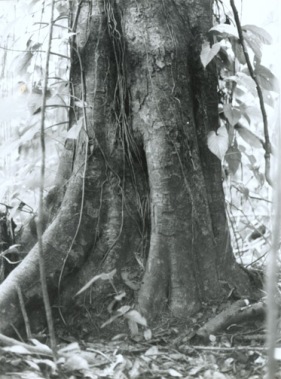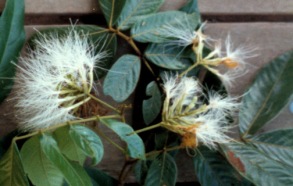Inga multijuga Benth.
Mimosaceae GUAJINIQUIL
Common sub-canopy evergreen tree (15-20 m) native to secondary forest areas and trailsides where light levels are high. This tree, the largest of all the Inga species found growing in MANP, is an important producer of fruit for arboreal mammals. It’s common name “Guajiniquil” is a generic label that also applies to any of the other trees belonging to this large genus.
 Description: Guajiniquil has a cylindrical, mostly straight trunk that occasionally may reach diameters as great as 60 cm. Mature individuals exhibit rough, thick, reddish-brown bark that exfoliates in irregularly shaped, angular plates. A moderate number of thin limbs, populated by a shell-like layer of foliage, create a dense, dark, relatively wide and rounded crown. Often, adventitious shoots or suckers can be observed growing out of the lower portion of the trunk. Leaves (17 by 17 cm) are pinnately compound, alternate, and very dark green. The five pairs of sessile leaflets, oppositely arranged along the petiole, are narrow, elliptical, and sharply pointed. Leaflet size increases uniformly with distance from the twig, ranging from 4 by 2 cm (proximally) to 9 by 3 cm (distally). Five circular glands are located on the petiole, positioned between each leaflet pair. All leaf surfaces are covered by varying amounts of fine, ferringineous hairs, with veins and petioles tending to receive the thickest coating. Old leaves senesce, turn yellow, and die in a process that is concurrent with new foliage formation in September and again in December.
Description: Guajiniquil has a cylindrical, mostly straight trunk that occasionally may reach diameters as great as 60 cm. Mature individuals exhibit rough, thick, reddish-brown bark that exfoliates in irregularly shaped, angular plates. A moderate number of thin limbs, populated by a shell-like layer of foliage, create a dense, dark, relatively wide and rounded crown. Often, adventitious shoots or suckers can be observed growing out of the lower portion of the trunk. Leaves (17 by 17 cm) are pinnately compound, alternate, and very dark green. The five pairs of sessile leaflets, oppositely arranged along the petiole, are narrow, elliptical, and sharply pointed. Leaflet size increases uniformly with distance from the twig, ranging from 4 by 2 cm (proximally) to 9 by 3 cm (distally). Five circular glands are located on the petiole, positioned between each leaflet pair. All leaf surfaces are covered by varying amounts of fine, ferringineous hairs, with veins and petioles tending to receive the thickest coating. Old leaves senesce, turn yellow, and die in a process that is concurrent with new foliage formation in September and again in December.  Flowers emerge in large (10 cm long by 8 cm in diameter), axillary spikes. Each 4 cm long blossom is sessile, with the pubescent sepals and petals fused into a five-pointed tubular calyx and corolla, respectively. As in other Ingas, the flower is dominated by twenty-five long, white, yellow-anthered stamens that give the spike a delicate, fuzzy appearance and that make it stand out when set against the backdrop of the dark-green canopy. Barely distinguishable from them, the single, central pistil is slightly thicker and longer than the surrounding stamens. Flowering occurs annually and over an extended period, though actual fertility during this time oscillates through a series of well-synchronized peaks and troughs. Lasting from late October to early March, activity is especially intense in December and February. Fruits are true pods, measuring 25 cm long and 2 cm wide. Glossy and pale green, each contains some fifteen shinny, green, bare seeds enclosed in fleshy, white arils. Harvests are consistent in their annual frequency as well as in their large magnitude, beginning in April and ending during June.
Flowers emerge in large (10 cm long by 8 cm in diameter), axillary spikes. Each 4 cm long blossom is sessile, with the pubescent sepals and petals fused into a five-pointed tubular calyx and corolla, respectively. As in other Ingas, the flower is dominated by twenty-five long, white, yellow-anthered stamens that give the spike a delicate, fuzzy appearance and that make it stand out when set against the backdrop of the dark-green canopy. Barely distinguishable from them, the single, central pistil is slightly thicker and longer than the surrounding stamens. Flowering occurs annually and over an extended period, though actual fertility during this time oscillates through a series of well-synchronized peaks and troughs. Lasting from late October to early March, activity is especially intense in December and February. Fruits are true pods, measuring 25 cm long and 2 cm wide. Glossy and pale green, each contains some fifteen shinny, green, bare seeds enclosed in fleshy, white arils. Harvests are consistent in their annual frequency as well as in their large magnitude, beginning in April and ending during June.
Similar Species: I. multijuga should be easy to recognize. It differs from all other Manuel Antonio Ingas in three respects: its leaves and flowers are relatively large, and it has ten leaflets per leaf. Guarea pyriformis and Cupania rufescens have paripinnate leaves of similar – though larger – shape and structure, but their petioles lack the glands found in this species.
Natural History: Inga multijuga flowers are pollinated by insects, bees and butterflies. The ariled seeds are among the favorite foods of white-faced and squirrel monkeys, though other mammals forage for them as well. Ecologically, Inga multijuga is a secondary forest species, requiring high light levels in order to survive. For this reason, it frequents trail sides and young stands of thin, regenerating vegetation. Nevertheless, it is occasionally found growing in older, mature forests where individuals may reach larger sizes and more advanced ages than are typical of most secondary, or pioneer, species.
Uses: (See I. punctata).
Distribution: I. multijuga be found in secondary forests and as a component of primary growth. Guajiniquil ranges from Belize to Panama.
